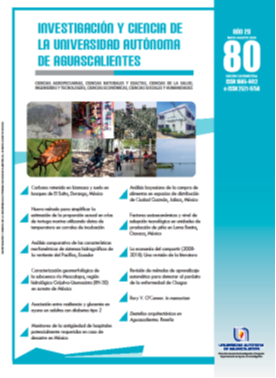New method of estimating sex proportion in sea turtle hatchlings using temperature data in hatcheries
DOI:
https://doi.org/10.33064/iycuaa2020802998Keywords:
nest temperature, sex ratio in hatchlings, sea turtle, sex determination, Lepidochelys olivaceaAbstract
The incubation temperature of sea turtle eggs determines the sex of the offspring. In recent years a bias towards females has been documented, so an easy and practical mathematical model was developed in MATLAB that uses the Girondot equation to estimate the proportion of males in a clutch. The program takes as input Excel files containing daily temperature records from the hatchery measured with a digital sensor similar to that of the proposed study, and laying date, hatching date, and number of eggs or live offspring from the nesting log. This model can be applied to different species of sea turtles and nesting beaches. A case study is presented for Lepidochelys olivacea (olive ridley turtle) at Playa Ceuta turtle rookery located in Sinaloa, Mexico.
Downloads
References
• Ackerman, R. A. (1997). The nest environment and the embryonic development of sea turtles. En P. L. Lutz, & J. A. Musick (Eds.), The Biology of Sea Turtles (pp. 83-106). Boca Raton, Florida: CRC Press.
• Fuentes, M. M. P. B., Hamann, M., & Limpus, C. J. (2010). Past, current and future thermal profiles of green turtle nesting grounds: Implications from climate change. Journal of Experimental Marine Biology and Ecology, 383(1), 56-64.
• Gibbons, J. W. (1970). Sex ratios in turtles. Researches on Population Ecology, 12, 252-254. doi: 10.1007/BF02511569
• Girondot, M. (1999). Statistical description of temperaturedependent sex determination using maximum likelihood. Evolutionary Ecology Research, 1, 479-486.
• Humason, G. L. (1979). Animal tissue techniques (4a ed., 661 pp.). San Francisco, CA, US: W. H. Freeman and Company.
• Jensen, M. P., Allen, C. D., Eguchi T., Bell, I. P., LaCasella, E. L., Hilton, W. A.,… Dutton, P. H. (2018). Environmental warming and feminization of one of the largest sea turtle populations in the world. Current Biology: CB, 28(1), 154-159. doi: 10.1016/j.cub.2017.11.057
• Limpus, C. (2008). Olive ridley turtle, Lepidochelys olivacea (Eschscholtz). En L. Fien (Ed.), A biological review of australian marine turtles (Vol. 4, 26 pp.). Queensland, Australia: Queensland Government Environmental Protection Agency.
• López-Correa, J., Porta-Gándara, M. A., Gutiérrez, J., & Gómez-Muñoz, V. M. (2010). A novel incubator to simulate the natural thermal environment of sea turtle eggs. Journal of Thermal Biology, 35(3), 138-142. doi: 10.1016/j.jtherbio.2010.01.005
• Marquardt, D. W. (1963). An algorithm for least-squares estimation of nonlinear parameters. SIAM Journal of the Society for Industrial and Applied Mathematics, 11(2), 431-441.
• McCoy, C. J., Vogt, R. C., & Censky, E. J. (1983). Temperaturecontrolled sex determination in sea turtle Lepidochelys olivacea. Journal of Herpetology, 17(4), 404-406. doi: 10.2307/1563594
• Merchant-Larios, H. (2000). Determinación del sexo en crías. En K. L. Eckert, K. A. Bjorndal, F. A. Abreu-Grobois, & M. Donnelly (Eds.), Técnicas de investigación y manejo para la conservación de las tortugas marinas (Trad., pp. 150-155). Suiza: Grupo Especialista en Tortugas Marinas UICN/CSE.
• Mrosovsky, N. (1980). Thermal biology of sea turtles. American Zoologist, 20(3), 531-547.
• Mrosovsky, N., & Yntema, C. L. (1980). Temperature dependence of sexual differentiation in sea turtles: Implications for conservation practices. Biological Conservation, 18(4), 271-280.
• Mrosovsky, N., Dutton, P. H., & Whitmore, C. P. (1984). Sex ratios of two species of sea turtle nesting in Suriname. Canadian Journal of Zoology, 62(11), 2227-2239. doi: 10.1139/z84-324
• Paukstis, G. L., & Janzen, F. J. (1990). Sex determination in reptiles: Summary of effects of constant temperature of incubation on sex ratios of offspring. Smithsonian Herpetological Information Service, 83, 1-28.
• Sandoval, S. (2012). Proporción sexual en crías de tortuga Lepidochelys olivacea en corrales de incubación del Pacífico Mexicano (Tesis de doctorado). Centro Interdisciplinario de Ciencias Marinas, Instituto Politécnico Nacional, La Paz B. C. S., México.
• Sandoval, S., Gómez-Muñoz, V. M., & Porta-Gándara, M. A. (2017). Expansion of the transitional range of temperature for sea turtle Lepidochelys olivacea from sex ratio data at controlled incubation temperatures. Herpetology Notes, 10, 63-65.
• Secretaría de Medio Ambiente y Recursos Naturales-Comisión Nacional de Áreas Naturales Protegidas. (2016). Prontuario estadístico y geográfico de las áreas naturales protegidas de México [Documento en pdf]. México: Autor. Recuperado de https://agua.org.mx/wp-content/uploads/2016/03/PRONTUARIO-ANP-2015.pdf
• Valenzuela, N., Literman, R., Neuwald, J. L., Mizoguchi, B., Iverson, J. B., Riley, J. L., & Litzgus, J. D. (2019). Extreme thermal fluctuations from climate change unexpectedly accelerate demographic collapse of vertebrates with temperaturedependent sex determination. Scientific Reports, 9, 4254. doi: 10.1038/s41598-019-40597-4
• Wibbels, T., Rostal, D., & Byles, R. (1998). High pivotal temperature in the sex determination of the olive ridley sea turtle, Lepidochelys olivacea, from Playa Nancite, Costa Rica. Copeia, 1998(4), 1086-1088. doi: 10.2307/1447364
• Yntema, C. L., & Mrosovsky, N. (1979). Incubation temperature and sex ratio in hatchling loggerhead turtles: A preliminary report. Marine Turtle Newsletter, 11, 9-10.
Downloads
Published
Versions
- 2020-06-30 (2)
- 2020-06-30 (1)
How to Cite
License
Las obras publicadas en versión electrónica de la revista están bajo la licencia Creative Commons Atribución-NoComercial-CompartirIgual 4.0 Internacional (CC BY-NC-SA 4.0)









